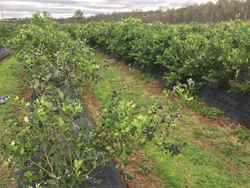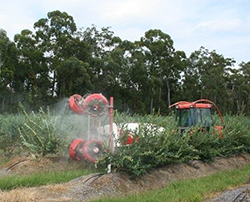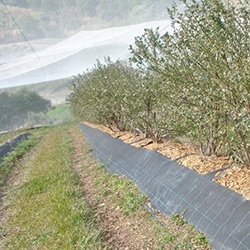Intensive horticulture and protected cropping
Guidance for farmers on the safe use of pesticides and requirements for training, record keeping and pesticide storage.
Pesticides training
 Pesticides can be harmful to farmers, the community and the environment if they are not used safely and correctly.
Pesticides can be harmful to farmers, the community and the environment if they are not used safely and correctly.
If you are employed in the horticulture industry and use any type of pesticide, including herbicides, insecticides or fungicides, training is compulsory under the NSW Pesticides Regulation 2017 (the Regulation).
The Pesticides Regulation 2017 requires farmers (and other occupational users of pesticides) to be accredited in specific chemical competencies. Training must be renewed every 5 years by completing a short refresher course. Unsupervised operators should have Australian Qualifications Framework (AQF) Level 3 training. If literacy is a problem, level 2 training is allowed only if operators are supervised by an AQF level 3 qualified person.
EPA authorised officers may ask for evidence of training at any time and if you are unable to show your current compulsory training accreditation in pesticides use, you will be fined $500.
Penalties also apply if you engage a person who is not trained and accredited to apply pesticides. The fine for a company is $1000.
See compulsory pesticide training.
If you hold a licence issued under the Pesticides Act 1999 for aerial application and commercial pest management technician’s work, different conditions apply.
Record keeping
You must make a record of pesticide application if you apply pesticides to crops by hand or powered equipment. This includes crops, cuttings, grafted plants or seedlings grown in orchards, open fields, nurseries, or in greenhouses. Even if you dip fruit or vegetables in a pesticide after harvesting to treat post-harvest moulds, fungi or insects you must make a record.
See the pesticide record keeping fact sheet for the horticultural industry (PDF 248KB) for guidance on record keeping.
You should check if your industry quality assurance scheme has additional requirements.
You must record the following information as soon as possible and no later than 48 hours after applying a pesticide:
- full product name
- name and description of crop treated
- application rate and quantity used
- equipment used
- property address and clear description of the area sprayed, including the order in which the area of land was sprayed
- date of application
- start and finish time
- wind speed and direction at the start of application and when there is a significant change plus any other weather conditions if specified on the label eg humidity
- name, address and contact details of the person who applied the pesticide. If the pesticide was applied by a person employed to apply the pesticide, the name, address and contact details of the employee
- name, address and contact details of the owner or occupier of the land (optional).
You do not need to make a record if you meet the domestic-like use small-scale exemption requirements detailed in the EPA Pesticide recordkeeping fact sheet for the horticultural industry.
Safe storage and handling of pesticides
Incorrectly stored pesticides pose a threat to the safety of workers, the community and the environment. Access must be restricted to authorised people only. See storage requirements at SafeWork NSW.
Pesticide containers must display the readable approved label labels. Damaged or faded labels must be replaced. Copies of approved labels or approved text for labels are available from the Australian Pesticides and Veterinary Medicines Authority (APVMA) PubCRIS web page.
- Pesticides must be stored in a secure designated area where any spills or emergencies can be controlled.
- Keep storage areas well organised to prevent spills.
- Clean up any spills immediately.
- Appropriate bunding prevents spills from entering the environment.
- Emergency equipment must be available such as an eye wash station, an emergency shower and spill kits
See the Storing pesticides safely on a farm factsheet from NSW Department of Primary Industries.
Wearing personal protective equipment (PPE) reduces your risk of accidental exposure or poisoning when handling pesticides, particularly when mixing products prior to spraying. Pesticide labels specify the PPE that must be used when handling a pesticide. Any pesticide on your hands can be easily ingested when drinking or smoking, or absorbed into your skin, which could cause poisoning.
SafeWork NSW’s code of practice provides detailed, practical and informative guidance for agricultural industries about how to conform with relevant legislation relating to the use and storage of chemicals including pesticides.
Safe use of pesticides
Product labels and safety data sheets include safe handling instructions, which must be explained to all workers if they are unable to read the instructions themselves.
If the wrong type or too much pesticide is used, the quality of the crop can be affected. If your crop has high levels of pesticide residues it may not be safe for people to eat and will be rejected for sale by retailers. Produce with high residues can be traced back to the grower, resulting in fines, if pesticides have been incorrectly used.
You must only use pesticides which are registered by the APVMA or approved by an APVMA permit for the purpose it is being used.
It is illegal to possess, prepare for use or use an unregistered pesticide in NSW unless you are authorised to use it under an APVMA permit. You must read the label or the permit directions or have them read to you, before use.
Under clause 57 of the Regulations you can use an insecticide or fungicide on an additional pest for blueberries if the crop is listed on the pesticide label. Under section 15 of the Pesticides Act you can use a lower rate as long as the label does not prohibit this when you are following all other instructions on the label. If you are considering using a lower rate seek specialist advice on resistance management of the pest you are trying to control.
Preventing spray drift and buffer zones
It is an offence under the Pesticides Act 1999 to injure people, damage property, harm non-target plants and animals or to use pesticides in a way that is likely to injure people or property. The maximum penalties for these offences are $60,000 for an individual and $120,000 for a business.
Winds can blow pesticides over long distances, causing them to drift onto neighbouring properties or into waterways. You should observe weather conditions and wind directions to determine when it is safe to spray. Do not apply pesticides when wind speeds are above 15 km/h, in gusty or in still conditions. You must identify nearby sensitive areas (including residential properties, schools and public amenities) prior to spraying.
Early communication between growers and neighbours about proposed pesticide use is encouraged for a good neighbour approach and is good practice.
 There is no formal requirement for a horticultural grower to provide a buffer unless required as a condition of development consent. However, it is good practice where incompatible land uses exist, such as adjoining homes, schools or waterways. Effective buffers reduce noise and odour. Buffers may be trees and shrubs or wide grassed areas.
There is no formal requirement for a horticultural grower to provide a buffer unless required as a condition of development consent. However, it is good practice where incompatible land uses exist, such as adjoining homes, schools or waterways. Effective buffers reduce noise and odour. Buffers may be trees and shrubs or wide grassed areas.
If a spray incident occurs and it has the potential to harm human health or the environment you have a duty to notify the EPA. Record the date, time, location, product used and duration of incident and report it by calling the EPA’s Environment Line on 131 555. More information on who and when to notify can be found on our duty to notify pollution incidents webpage.
Rinsate management
Rinsate is a mixture of pesticides diluted by water, solvents, oils, commercial rinsing agents or any other substances. It is produced from cleaning equipment used for pesticide application, or pesticide containers. The inappropriate disposal of pesticide rinsate can harm people and the environment.
Never dispose of pesticides and their rinsate down creeks, rivers or stormwater drains. You can be prosecuted for allowing pesticides to pollute waters.
Our Guidelines for managing the disposal of pesticide rinsate (PDF 126KB) provides practical solutions for reducing the amount of rinsate generated and advice on safe disposal.
Disposing empty containers or concentrate
Empty, clean pesticide containers marked with the drumMUSTER logo can be taken to a drumMUSTER collection point for recycling.
Containers must be rinsed three times. Rinsate should be tipped back into the spray tank and re-applied over the crop.
- contact DrumMUSTER on 1800 008 707
- contact ChemClear® to collect and safely dispose of unwanted agricultural and veterinary chemicals on 1800 008
Managing run-off and preventing soil erosion
You must ensure that you do not cause water pollution.
Maintaining permanent groundcovers between rows and near waterways minimises erosion. You can reduce erosion by limiting the amount of water entering the cultivated area, and diverting water around the area by building diversion drains and capturing water into a dam or a sedimentation pond.
Surface run-off should be diverted into the your water supply dam for storage and re-use. Before designing any new water storages you should check dam water storage rules with the Natural Resource Access Regulator and your local Council. Sub-surface drainage may help very wet areas.
A correctly designed and regularly maintained irrigation system will help to manage nutrient run-off. This should include a wastewater capture and re-use system, or a vegetated buffer strip that prevents wastewater flowing to or leaching into surface and groundwater. Any wastewater capture and reuse, or irrigation system should be designed and installed by qualified professionals to ensure there is no impact to surface or groundwater.

You should sample and test fertigation water regularly to manage nutrient loads and ensure that excess nutrients will not run-off. Run-off from fertiliser application can cause a high-level of nutrients entering water courses and causing environmental harm.
Integrated pest management
An integrated pest management strategy relies on using the correct pesticide for the situation. Pesticide rotation ensures the pest, disease or weed is not continually exposed to the same Mode Of Action group shown under the activity group identification symbol on the pesticide label.
When a pest problem arises, consider all control options available. Consider using a pest resistant variety of crop, or biological controls where there is an an effective option. Some growers are moving away from broad spectrum pesticides and are adopting an integrated approach to pest and disease management. Biological control includes use of insect predators to control pest outbreaks. If it is necessary to apply a pesticide, consider the range of effective options and choose the one which may have the least impact on the environment and biological control agents.
Blueberry growers
NSW DPI has developed a best management practice guideline for new and existing blueberry growers in the northern NSW. It provides comprehensive information about soil and water management for the region.
NSW DPI’s berry plant protection guide provides comprehensive information for commercial blueberry growers with current technical information on all aspects of crop protection including biological control and pesticide resistance management.

